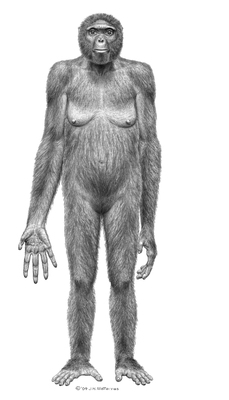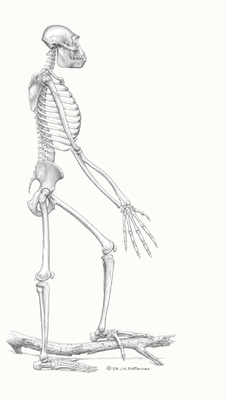
by Erin Wayman Thursday, January 5, 2012

An artist's reconstruction of _Ardipithecus ramidus_. Illustration 2009, J.H. Matternes

Reconstruction of the 'Ardi' skeleton. Illustration 2009, H.J. Matternes
Lucy, the 3.2-million-year-old Australopithecus afarensis fossil, has long been the poster child for early human evolution. But now she’ll have to share the spotlight with an even older hominid. After spending the last 15 years studying an ancient hominid species about the size of a chimpanzee, scientists revealed details about the 4.4-million-year-old Ardipithecus ramidus in a press conference today. Despite the similarity in size, Ardipithecus didn’t look or act like a chimpanzee, which the researchers say suggests that the last common ancestor of chimpanzees and humans was not chimpanzee-like either. As a result, they said, scientists may need to rethink some long-standing ideas about the origins of the human family tree.
Although Ardipithecus is not the oldest known hominid, the new work represents the most complete study of a hominid older than 4 million years. Scientists think the human and chimpanzee lineages split sometime between 10 million and 7 million years ago, so Ardipithecus ramidus is the closest we’ve ever come to knowing what the two species' common ancestor might have looked like, said Tim White of the University of California at Berkeley, at today’s press conference.
Like Lucy and many other hominid fossils, Ardipithecus ramidus was found in Ethiopia’s Afar Depression. But Ardipithecus ramidus represents “a host of revelations about early human evolution that Lucy never provided us,” said co-investigator C. Owen Lovejoy of Kent State University in Ohio. “It’s just a treasure trove of surprises.”
White and Lovejoy are two of 47 scientists — including Berhane Asfaw of Rift Valley Research Service in Addis Ababa, Ethiopia, Giday WoldeGabriel of Los Alamos National Laboratory in New Mexico and Gen Suwa of the University of Tokyo in Japan — co-authoring a series of 11 papers about Ardipithecus ramidus that will be published tomorrow in Science.
Beginning in 1992 and throughout the early 1990s, the researchers uncovered more than 100 Ardipithecus ramidus fossil specimens that represent more than 35 individuals as well as a well-preserved, partially complete skeleton, nicknamed “Ardi.” Ardipithecus ramidus was an adept tree climber and was also capable of walking upright, or bipedally, when on the ground. Geological evidence, including analyses of the ancient soil and animal fossils, suggests that Ardi lived in a woodland environment. Finding an early upright walker living in a forested area refutes one of the traditional explanations for the evolution of bipedalism: that hominids became upright in response to moving into open, savanna grasslands, White said.
But the bones also paint an unexpected picture of an early hominid: Despite its bipedalism, Ardipithecus was more primitive than chimpanzees in many ways — negating the idea that the last common ancestor of chimpanzees and humans was chimpanzee-like, as some scientists have assumed. For example, Ardipithecus ramidus was not an arboreal acrobat like chimpanzees and gorillas, the researchers say. Chimpanzees and gorillas rely on their long, strong arms and hands, their curved fingers and their grasping feet to climb trees, swing through the canopy and hang from branches while feeding. But Ardipithecus lacked those features: Instead, it walked on all fours on top of the tree branches, similar to how monkeys move through the trees.
Many scientists thought humans evolved from an ape similar to chimpanzees and gorillas — one that swung through the trees and knuckle-walked while on the ground. But this new information suggests that — like Ardipithecus — the last common ancestor of chimpanzees, gorillas and humans also had a more primitive form of locomotion, the researchers say. Therefore, chimpanzees didn’t evolve their specialized climbing and knuckle-walking until after they diverged from humans — which also implies that chimpanzees and gorillas likely evolved this form of locomotion independently as other recent research has suggested.
Ardipithecus ramidus’ form of bipedalism was also primitive, says Brian Richmond, a paleoanthropologist at George Washington University in Washington, D.C., who is not affiliated with the research. It’s not clear what the hominid’s version of walking would have looked like, but Richmond notes it probably took shorter, less efficient steps than modern humans do: With its big toe off to the side rather than in line with the other toes, Ardipithecus ramidus could not use the toe to push off and take long strides.
Given the extensive reconstruction of some of the fossils, some scientists are not convinced that the evidence definitely demonstrates Ardipithecus ramidus walked upright. The researchers point to features of the pelvis — such as hip muscles that are positioned on the side of the body, as they are in modern humans, to maintain balance while walking — as proof that Ardipithecus ramidus was bipedal. But the one known Ardipithecus ramidus pelvis had been crushed, so the researchers had to reconstruct it to learn anything. That, says Carol Ward, an anatomist at the University of Missouri in Columbia, makes any interpretation “equivocal.”
As for the environment, there’s “no doubt that [Ardipithecus] was adapted for an arboreal lifestyle,” Ward says. But where Lovejoy, White and their colleagues see primitive, monkey-like climbing, Richmond still sees typical chimpanzee- and gorilla-like features. “The hands and feet look like an ape,” he says. “They would have been capable of climbing the way chimps and gorillas climb.”
Still, with all of this new evidence, “the idea that we came from a chimp-like ancestor is highly unlikely,” Ward says. And therefore, given a different starting point, researchers will need to reframe many of the questions about how and why hominids started down the human path.
But this is hardly the end of the discussion — and many more scientists are likely to weigh in on the fossils. “It’s an almost unprecedented collection of fossils,” Ward says. “There’s a tremendous amount of information in [them] … and decades of questions to be addressed.”
To learn more about the discovery and analysis of Ardipithecus ramidus, check out “Discovering Ardi,” a documentary airing on the Discovery Channel on Oct. 11.
© 2008-2021. All rights reserved. Any copying, redistribution or retransmission of any of the contents of this service without the expressed written permission of the American Geosciences Institute is expressly prohibited. Click here for all copyright requests.